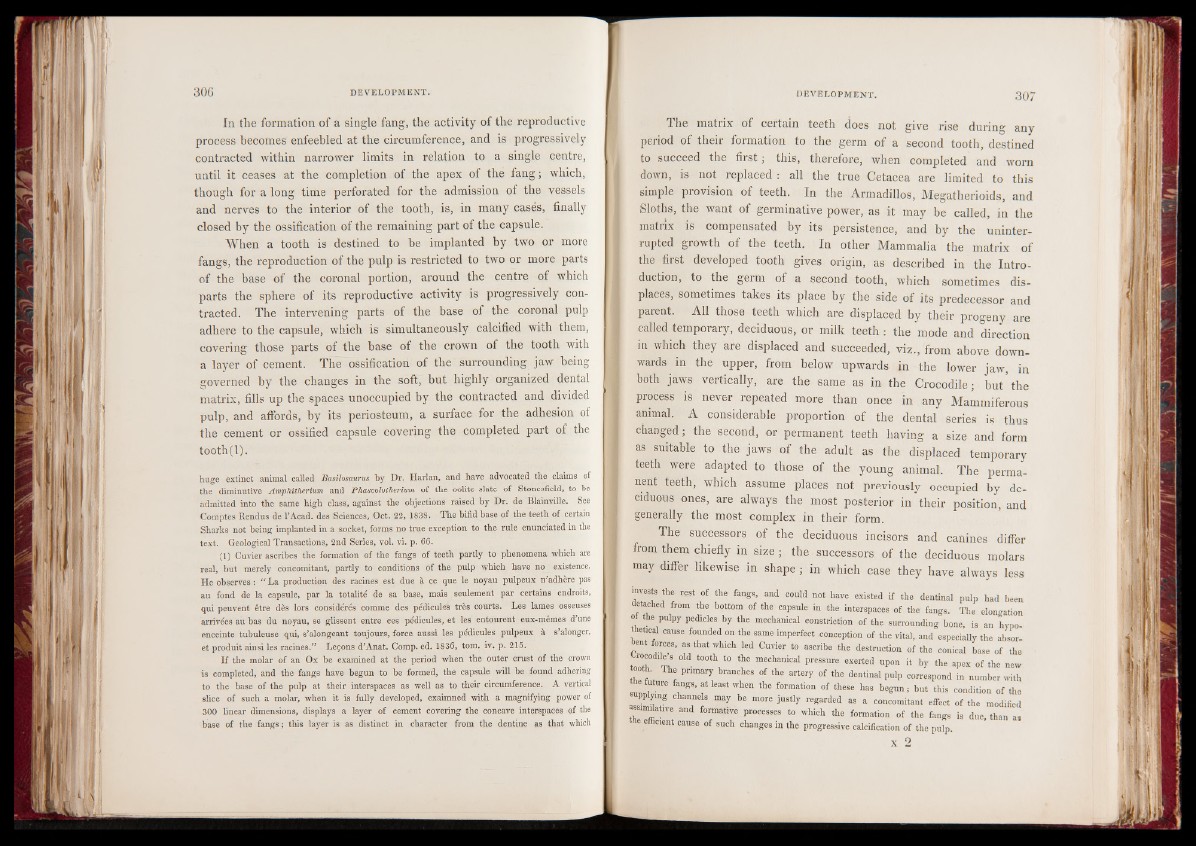
In the formation of a single fang, the activity of the reproductive
process becomes enfeebled at the circumference, and is progressively
contracted within narrower limits in relation to a single centre,
until it ceases at the completion of the apex of the fang ; which,
though for a long time perforated for the admission of the vessels
and nerves to the interior of the tooth, is, in many casés, finally
closed by the ossification of the remaining part of the capsule.
When a tooth is destined to he implanted by two or more
fangs, the reproduction of the pulp is restricted to two or more parts
of the base of the coronal portion, around the centre of which
parts the sphere of its reproductive activity is progressively contracted.
The intervening parts of the base of the coronal pulp
adhere to the capsule, which is simultaneously calcified with them,
covering those parts of the base of the crown of the tooth with
a layer of cement. The ossification of the surrounding jaw being
governed by the changes in the soft, hut highly organized dental
matrix, fills up the spaces unoccupied by the contracted and divided
pulp, and affords, by its periosteum, a surface for the adhesion of
the cement or ossified capsule covering the completed part of the
tooth(l).
huge extinct animal called Basilosmrus by Dr. Harlan, and have advocated the claims of
the diminutive Amphitherium and Phascolotherium of the oolite slate of Stonesfield, to be
admitted into the same high class, against the objections raised by Dr. de Blainville. See
Comptes Rendus de l’Acad. des Sciences, Oct. 22, 1838. The bifid base of the teeth of certain
Sharks not being implanted in a socket, forms no true exception to the rule enunciated in the
text. Geological Transactions, 2nd Series, vol. vi. p. 66.
(1) Cuvier ascribes the formation of the fangs of teeth partly to phenomena which are
real, but merely concomitant, partly to conditions of the pulp which have no existence.
He observes : “ La production de3 racines est due à ce que le noyau pulpeux n'adhère pas
au fond de la capsule, par la totalité de sa base, mais seulement par certains endroits,
qui peuvent être dès lors considérés comme des pédicules très courts. Les lames osseuses
arrivées au bas du noyau, se glissent entre ces pédicules, et les entourent eux-mêmes d’une
enceinte tubuleuse qui, s’alongeant toujours, force aussi les pédicules pulpeux à s’alonger,
et produit ainsi les racines.” Leçons d’Anat. Comp. ed. 1836, torn. iv. p. 215.
If the molar of an Ox be examined at the period when the outer crust of the crown
is completed, and the fangs have begun to be formed, the capsule will be found adhering
to the base of the pulp at their interspaces as well as to their circumference. A vertical
slice of such a molar, when it is fully developed, exaimned with a magnifying power of
300 linear dimensions, displays a layer of cement covering the concave interspaces of the
base of the fangs; this layer is as distinct in character from the dentine as that which
The matrix of certain teeth does not give rise during any
period of their formation to the germ of a second tooth, destined
to succeed the first ; this, therefore, when completed and worn
down, is not replaced : all the true Cetacea are limited to this
simple provision of teeth. In the Armadillos, Megatherioids, and
Sloths, the want of germinative power, as it may be called, in the
matrix is compensated by its persistence, and by the uninterrupted
growth of the teeth. In other Mammalia the matrix of
the first developed tooth gives origin, as described in the Introduction,
to the germ of a second tooth, which sometimes displaces,
sometimes takes its place by the side of its predecessor and
parent. All those teeth which are displaced by their progeny are
called temporary, deciduous, or milk teeth : the mode and direction
in which they are displaced and succeeded, viz., from above downwards
in the upper, from below upwards in the lower jaw, in
both jaws vertically, are the same as in the Crocodile; but'the
process is never repeated more than once in any Mammiferous
animal. A considerable proportion of the dental series is thus
changed; the second, or permanent teeth having a size and form
as suitable to the jaws of the adult as the displaced temporary
teeth were adapted to those of the young animal. The permanent
teeth, which assume places not previously occupied by deciduous
ones, are always the most posterior in their position, and
generally the most complex in their form.
The successors of the deciduous incisors and canines differ
from them chiefly in size ; the successors of the deciduous molars
may differ likewise in shape; in which case they have always less
invests the rest of the fangs, and could not have existed if the dentinal pulp had been
detached from the bottom of the capsule in the interspaces of the fangs. The elongation
ot the pulpy pedicles by the mechanical constriction of the surrounding bone, is an hypo-
etical cause founded on the same imperfect conception of the vital, and especially the absorbent
forces, as that which led Cuvier to ascribe the destruction of the conical base of the
m m 0ld. t00tV ° the m“ hanical pressure exerted upon it by the apex of the new
ooth The primary branches of the artery of the dentinal pulp correspond in number with
be future fangs, at least when the formation of these has begun; but this condition of the
assimC8 R B I m°re JUStly regarded “ a ■ M and f°” e P concomitant ^ c t of the modified ftcient cause of such ch“an“ge8s8 6i8n tth0e wphroicghre ssive fcoarlmciafitcioanti ono fo ft hthee fpaunlgps. is due, than as
x 2